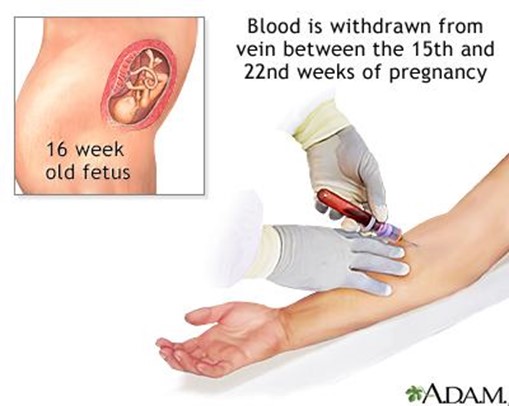A pregnant woman undergoes a triple/quadruple screen at 16 to 18 weeks' gestation. What would the nurse suspect if the woman's alpha-fetoprotein (AFP) level is decreased?
Sickle-cell anemia
Cardiac defects
Down syndrome
Respiratory disorders
The Correct Answer is C
Choice A Reason: This is incorrect because sickle-cell anemia is a genetic disorder that affects the shape and function of the red blood cells. It is not related to the AFP level, which is a protein produced by the fetal liver and yolk sac.
Choice B Reason: This is incorrect because cardiac defects are abnormalities in the structure or function of the heart. They are not related to the AFP level, which is a marker of neural tube defects and abdominal wall defects.
Choice C Reason: This is correct because Down syndrome is a chromosomal disorder that results from an extra copy of chromosome 21. It is associated with a decreased AFP level, as well as increased levels of human chorionic gonadotropin (hCG) and unconjugated estriol (uE3).
Choice D Reason: This is incorrect because respiratory disorders are problems that affect the lungs and breathing. They are not related to the AFP level, which reflects the fetal development and integrity.
Nursing Test Bank
Naxlex Comprehensive Predictor Exams
Related Questions
Correct Answer is C
Explanation
Choice A Reason: This is incorrect because sickle-cell anemia is a genetic disorder that affects the shape and function of red blood cells. It does not affect the AFP level, which is a protein produced by the fetus and placenta. Sickle-cell anemia can be detected by other prenatal tests, such as hemoglobin electrophoresis or DNA analysis.
Choice B Reason: This is incorrect because cardiac defects are structural abnormalities of the heart or blood vessels that affect the blood flow and oxygen delivery to the fetus. They may cause an increased AFP level, not a decreased one, as they can lead to fetal distress or edema. Cardiac defects can be detected by other prenatal tests, such as fetal echocardiography or ultrasound.
Choice C Reason: This is correct because Down syndrome is a chromosomal disorder that results from an extra copy of chromosome 21. It causes various physical and mental developmental delays and defects in the fetus. It is associated with a decreased AFP level, as well as decreased levels of human chorionic gonadotropin (hCG) and unconjugated estriol (uE3). Down syndrome can be confirmed by other prenatal tests, such as amniocentesis or chorionic villus sampling (CVS).
Choice D Reason: This is incorrect because respiratory disorders are problems that affect the breathing and gas exchange of the fetus. They may cause an increased AFP level, not a decreased one, as they can lead to fetal distress or edema. Respiratory disorders can be detected by other prenatal tests, such as fetal biophysical profile (BPP) or nonstress test (NST).

Correct Answer is B
Explanation
Choice A Reason: This is incorrect because maternal diabetes is a condition where the mother has high blood sugar levels during pregnancy. It can cause polyhydramnios, or excess amniotic fluid, not oligohydramnios, or low amniotic fluid.
Choice B Reason: This is correct because fetal anencephaly is a congenital defect where the fetus lacks parts of the brain and skull. It can cause oligohydramnios, as the fetus does not produce enough urine to contribute to the amniotic fluid volume.
Choice C Reason: This is incorrect because placental abruption is a complication where the placenta detaches from the uterine wall before delivery. It can cause bleeding, pain, and fetal distress, but not oligohydramnios.
Choice D Reason: This is incorrect because neural tube defects are congenital defects where the spinal cord or brain does not develop properly. They can cause various neurological problems, but not oligohydramnios.

Whether you are a student looking to ace your exams or a practicing nurse seeking to enhance your expertise , our nursing education contents will empower you with the confidence and competence to make a difference in the lives of patients and become a respected leader in the healthcare field.
Visit Naxlex, invest in your future and unlock endless possibilities with our unparalleled nursing education contents today
Report Wrong Answer on the Current Question
Do you disagree with the answer? If yes, what is your expected answer? Explain.
Kindly be descriptive with the issue you are facing.
